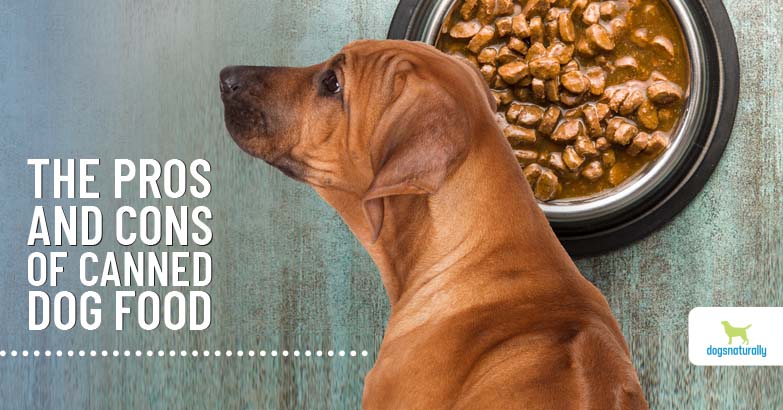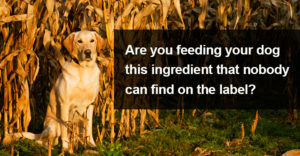If you want convenience in dog food, you might wonder about feeding canned dog food.
Canned food could have some advantages over kibble. For one thing, you can store it a lot longer. But it is better or worse for your dog?
Well … the quality of both kibble and canned dog foods varies enormously. So that question doesn’t have a short answer. But I’ll explain some of the main pros and cons of canned food.
First, a little history.
History Of Canned Dog Food
Growing up on a farm in the UK, I never saw kibble … though it did exist. (I’m not quite that old.)
My dad was a farmer who didn’t appreciate critters eating his crops. So there was usually a pot of some cheaper game like rabbit or pigeons bubbling on the stove for his working Springer Spaniels. (Our kitchen smelled terrible.) But the dogs were fit and athletic … and they rarely needed a vet. Sometimes they got our leftovers.
But sometimes he popped open some canned dog food for them. I even remember the brand: PAL, which stood for prolongs active life.
Kibble emerged as a popular dog food in the 1950s. But canned food has been around for about 100 years. Ken-L-Ration was the first canned dog food. During World War II there was less canned food available because they needed the metal for the war effort. But the industry picked up again after the war.
Today, kibble is by far the most popular dog food. US canned dog food sales are about 1/3 of US kibble sales.
Canned Food Regulations
The US Federal Food, Drug, and Cosmetic Act (FFDCA) requires that …
“ … all animal foods be safe to eat, produced under sanitary conditions, contain no harmful substances, and be truthfully labeled.“
Canned pet foods must also comply with low acid canned food regulations. That’s to keep the food free of viable microorganisms.
In other words, canned dog food is completely sterile. It has no bacteria until you open the can.
But there are potential safety issues with the cans themselves. I’ll get into that in a minute.
Convenience Of Canned Dog Food
Of course, it’s obvious canned food is convenient. Just pop open the can and tip it into your dog’s bowl. Nowadays you may not even need a can opener, thanks to ring pulls and peelable lids.
So that makes canned an easy option to feed your dog at home or on the road. (Except for the weight – not a good choice for backpacking!)
Canned Dog Food Storage
Canned food keeps just about forever. North Dakota State University says canned meats keep up to 5 years. After opening you’ll need to refrigerate them … and then they’ll keep for 3-4 days.
But that can create some safety issues with canned dog food.
Canned Dog Food Safety
Most cans are lined with plastic – supposedly for safety. But that plastic contains a chemical called Bisphenol-A (BPA). BPA can leach into your dog’s food. And that’s a problem.
BPA can damage some important biological systems in your dog, like …
- Neurological
- Endocrine
- Cardiovascular
- Reproductive
- … and it may increase the risk of breast and prostate cancers
The European Union calls it a “substance of very high concern.” And California lists BPA on ts Proposition 65 list of harmful chemicals. But the FDA disagrees.
FDA Response To BPA
FDA scientists in 2011 admitted BPA “migrates into can contents during processing and storage” But they haven’t done anything to stop manufacturers from using BPA.
Despite many third-party studies and public petitions … the FDA says its own review shows that BPA is safe. They did grant two petitions to stop the use of BPAs in baby products. But not because of safety! It was because baby product manufacturers stopped using BPAs – so they didn’t need to regulate it anymore!
Anyway … major manufacturers have reduced their use of BPA due to public demand. But the Center for Environmental Health (CEH) reported in 2018 that 38% of cans from 4 large retail chains still use BPA linings.
And companies that have moved away from BPA have replaced it with other materials that might be toxic. I’ll get to the alternatives in a bit.
BPA In Dog Foods
Most information about BPA in canned food is about human products. But there have been a couple of studies of canned dog foods.
One Dutch study found that BPA in dog food did not cause toxicity “within relatively short periods of time.”
(Does this research make sense? Dogs eat these foods for their whole lives! So it’s not a very useful study. And the primary researcher works for a Dutch dog food company. So he might be biased.)
But the researchers did admit that research in rodents shows …
… low intake of BPA can “imitate and oppose some of the body’s hormones.”
Endocrine problems like hypothyroidism may appear as dogs age. “Basic research suggests that low BPA intakes can have negative health effects in the long term.”
In contrast, another very small study of 14 dogs found that after 2 weeks on canned food, the dogs had …
- Triple the previous levels of BPA in their blood
- Fecal microbiome alterations … meaning BPA can impact your dog’s gut
So it’s there are potential health issues with BPA. Avoid BPA lined cans if you can.
How To Avoid BPA
You can check the Seeking Safer Packaging website. This group assesses major food companies’ use of BPA. It’s not specific to pet food companies. But many of the major ones are owned by big food conglomerates. So, with a bit of detective work, you might find some information about your dog’s canned food maker.
Unfortunately, there’s no easy way to tell whether your dog’s canned food contains BPA. You’ll probably need to call the company, because most labels don’t report this information. Sometimes the website will claim the product is “BPA free.”
But in that case, what are they using instead?
Alternative Can Linings
EWG (Environmental Working Group) published a November 2020 update on can linings. The Can Manufacturers Institute says that 95% of food cans are now made without BPA linings. BPA is often replaced with …
- Acrylic
- Polyester
- Non BPA epoxies
- Olefin polymers
The Institute claims these products are safe. They say that other BPA substitutes like BPS (Bisphenol-S) aren’t used. (That’s a good thing, because BPS mimics estrogen and disrupts the endocrine system.)
But there’s still no research showing that these alternative can linings are safe. And even if you ask the company, you won’t usually get full disclosure of can liner chemicals. So, sadly, we can’t yet advise you what type of liner to look for.
So, if you feed canned dog food, it’s safest to use it within a few weeks of buying it. (Of course, this negates the long storage advantage of canned food)! And once opened, refrigerate any leftovers in a glass storage container.
The Cost Of Canned Dog Food
The price of canned dog foods varies hugely. Typical can size is around 12.5 to 13.5 oz. Here are some price ranges. You’ll notice quite a difference!
- Premium brands: $2.80 to $8 a can
- Prescription or veterinary diets: $3.25 to nearly $8 a can
- Supermarket brands: $1.50 per can upwards
So (except for veterinary diets which aren’t any better quality than supermarket brands) … you get what you pay for. Choose premium canned brands when you an afford them.
But even the cheaper brands are a lot more expensive than kibble.
Canned foods are mostly moisture, while kibble is very dry. So, to compare them, you have to subtract the moisture percentage. I won’t make you do the math … but paying $2.50 for a can works out about the same as paying $12 a lb for kibble. That’s about 3 or 4 times what even a premium kibble costs.
Or, to look at it another way, feeding a 20 lb dog would cost about between $3-$4 a day, compared to less than $1 a day for kibble.
But that’s not a totally fair comparison. That’s because kibble has a lot more fillers and starches. I’ll get to that when I talk about nutrition in canned dog foods.
How Canned Dog Food Is Made
When canned foods were first made they had trouble stopping the food from spoiling. You had to watch for bulging cans, which indicated the food had gone bad. Botulism (deadly food poisoning) was a risk with early canned foods.
Nowadays that risk is almost zero. Canned dog food today is sterile. It contains no bacteria, mold or virus (at least until you open it).
The Canned Dog Food Process
Canned food machinery usually includes …
- A mixer
- A steam jacketed kettle for preheating
- A filling machine
- The retort – a high temperature machine that sterilizes the food
- A machine that sticks the label on the can and boxes it up
Here’s what they do:
- The mixer grinds up the ingredients, including vitamins and minerals.
- The kettle heats the food.
- Temperature depends on the carbohydrate content. Starchier foods need higher temperatures.
- The filling machine puts the food in the cans and seals on the lid. The retort heats the cans to sterilize the food. Next they’re cooled, labeled and stacked in boxes.
PRO TIP
Read your labels carefully! The canning process allows food scientists to get creative with ingredients. Food that looks like chicken could be made of pea protein isolate and tapioca starch.
So, now for the most important question. Is canned food good for your dog?
RELATED: The pros and cons of how different types of dog food are made …
What’s Not In The Can
Canned foods are usually a healthier option for your dog. Here are some key disadvantages of kibble compared to canned food.
Some Kibbles Contain Rendered Ingredients
Rendering means heating and pressurizing inedible ingredients like meat by-products. Rendering removes moisture and pathogens from the food. Meat meals are rendered.
Environmentally, it means less waste. But it can mean really poor nutrition. Some rendered foods contain wrapping materials, roadkill or euthanized animals.
Most canned food doesn’t have rendered meats.
Kibble Is Extruded
The extrusion process is a high pressure, high heat cooker. It makes grains more digestible. But high temperatures denature the proteins. Denatured proteins may contribute to food allergies.
Canned foods don’t use extrusion.
Kibble Has More Starches
Kibble has to have a lot of starch. That’s what holds those little nuggets together!
But dogs don’t need starch in their diets. And they don’t digest it very efficiently. We humans can digest starches better because we have the enzyme amylase in our mouths. That helps predigests the food when we chew it. But dogs don’t have that benefit. (And you might have noticed they don’t chew their food much either. It’s more of a chomp and gulp process.)
Watch out for cheaper varieties of canned foods that might have more starch. Even so, canned foods are much less starchy then kibble.
Kibble May Be Higher Calories
Kibble’s a concentrated source of calories … and it’s more likely to make your dog fat! The starch is also a factor in causing dog obesity.
Canned food could help your dog stay leaner.
Kibble Dehydrates Your Dog
This is a worse problem for cats. But dry foods can be very dehydrating if your dog doesn’t drink enough to compensate.
Kibbles average 10% to 12% moisture, compared to canned at 75% to 84%. So if you switch from dry to wet food, you’ll likely notice your dog drinking much less water,
Canned food will keep your dog better hydrated. (As one well-known slogan says, hydrate or die!)
Kibble Contains Synthetic Nutrients
Nearly all kibbles contain synthetic vitamins and minerals. Synthetic nutrients aren’t well absorbed by the body … and they can be harmful long term.
Canned foods are less likely to need these additives. Canned food is less processed … so the nutrients are less likely to be depleted.
RELATED: Synthetic vitamins and minerals in dog foods ...
PRO TIP
When you choose any commercial dog food, look for one without synthetic vitamins and minerals. That’s a good indication the ingredients are good enough to nourish your dog without the additives. Very few kibbles are synthetic-free (though there are some). Because they’re less processed, canned foods are less likely to need those synthetics.
Kibble Contains Artificial Preservatives
Kibble doesn’t keep well. So it needs preservatives to make it shelf stable. These preservatives are almost always artificial.
The sterility of canned food means it doesn’t need preservatives.
Kibble Contains Fillers
You’ll often see ingredients like beet pulp or cellulose in kibble. These have little to no nutritional value and are just there for bulk and fiber. Cellulose is basically sawdust.
Ever notice the size of dog poop? Kibble poop is much bigger than other foods. That’s because your dog poops out all those indigestible fillers.
Canned food doesn’t usually contain those fillers. Though you may find some unnecessary starches in cheaper brands.
So there are lots of ingredients in kibble that you won’t find in canned foods. But canned foods also have some ingredients that aren’t in kibble.
Canned Food Additives
Canned food may contain other additives to thicken the food:
- Guar gum – a soluble fiber from the guar bean. It may cause weight loss and lower blood sugar. It could also cause digestive issues like gas.
- Xanthan gum – a polysaccharide (sugar molecule) from fermented bacteria. It can sometimes cause loose stool.
- Carrageenan – polysaccharide from red algae. Carrageenan is controversial because it may be linked to some cancers. It can also contribute to gastrointestinal inflammation … leading to leaky gut and autoimmunity.
If you can, choose a canned food without carrageenan.
I talked about BPA earlier. BPA can be in some kibble packaging too, but it’s more likely in canned foods.
Nutritional Quality Of Canned Dog Food
Like all commercial dog foods, there’s a wide range of quality. But generally, canned foods are better quality than kibble.
Compared to kibble, canned foods are …
- Less processed, so food nutrients are less damaged
- Cooked at lower temperatures – again, less nutrient depletion
- Less likely to need synthetic vitamins and minerals, due to less processing/lower heat
- Much lower in carb content – usually up to 7.5% for canned vs 30% to 40% (sometimes more!) for kibble
- More digestible – 95-100% digestible vs about 75% for kibble
- Higher in animal protein – kibbles often rely on plant-based proteins like legumes. These are inferior protein types for dogs … and they can contain harmful lectins.
RELATED: 5 things all dog owners should know about lectins ...
Canned Food May Lower Bloat Risk
One other thing I didn’t mention is the risk of bloat. Bloat is a serious, often deadly condition. It can happen in any breed but is more common in large, deep-cheste dogs.
Your dog’s stomach fills with gas and twists, blocking off whatever’s inside. Gases build up, putting pressure on your dog’s organs. It can cut off return blood flow to the heart. This can make your dog go into shock very quickly.
One risk factor for bloat is feeding kibble. But a study at Purdue University showed that dogs on a mainly kibble diet had a far lower risk of bloat when table food or canned food was added to their diets. For large breed dogs, the risk was 59% less, and 28% less for giant breeds.
RELATED: Preventing bloat in dogs naturally
Supplementing Canned Foods
In theory, you shouldn’t need to supplement canned food (or kibble!). Most of these foods are usually sold as “complete and balanced.” That means they should provide all the nutrition your dog needs.
But both kibble and canned foods are cooked.
- Cooking causes nutrient loss.
- Cooking denatures proteins … meaning they can’t do their job any more.
- Cooking destroys live enzymes in the food.
So with both types of food, you may want to help your dog with some digestive enzymes. And pre and probiotics are also a good idea to support your dog’s gut health.
Another good addition is a source of omega-3 fats. Even if they’re in the food (whether kibble or canned), they won’t usually survive the cooking process. And they may even be rancid … and that can be toxic for your dog. So it’s actually better to look for a food without added omega-3 fats.
Pros And Cons Of Canned
So, let’s summarize the pros and cons of canned dog food compared to kibble:
Canned Dog Food – Pros
- Convenient
- Better quality nutrition (less starch, better protein)
- No indigestible fillers
- Less likely to have synthetic vitamins and minerals
- Easy to store, with long shelf life
- May lower risk of bloat
Canned Dog Food – Cons
- More expensive
- Potential toxicity from BPA or other can linings
So, if you’re currently feeding kibble … you could improve the quality of your dog’s diet by giving him canned food. It’s more expensive, but your dog’s health will benefit.
References
Beynen AC. BPA in canned petfood. Creature Companion. 217:33-4.
Koestel ZL, Backus RC, Tsuruta K, Spollen WG, Johnson SA, Javurek AB, Ellersieck MR, Wiedmeyer CE, Kannan K, Xue J, Bivens NJ, Givan SA, Rosenfeld CS. Bisphenol A (BPA) in the serum of pet dogs following short-term consumption of canned dog food and potential health consequences of exposure to BPA. Science of The Total Environment. 2017 Feb 1;579:1804-14.
Glickman LT et al. Non-dietary risk factors for gastric dilatation-volvulus in large and giant breed dogs. Journal of American Animal Hospital Association. 2000;217(10):1492-99.












